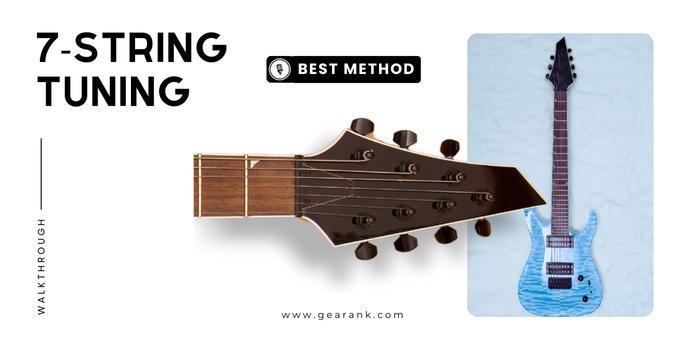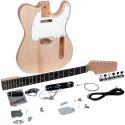A Walkthrough: The Best Method for 7-String Tuning

Just got a new 7-string guitar and want to know 7 string tuning?
A 7-string guitar is not that different from a 6-string guitar. It has an added bass string that expands low-frequency notes.
This means you only have to tune one more string than usual, which is not much harder than a regular 6-string guitar.
In this article, I will share the precise steps required to tune a 7-string guitar to standard tuning. Additionally, I will provide a comprehensive overview of the alternative and drop tunings that are frequently employed by 7-string guitar enthusiasts.
This article is divided into these main sections:
-
What is A Seven String Guitar?
-
Standard Tuning on Seven-String Guitars
-
Other Alternate Tunings
-
Why Tune Down or Drop Tune?
-
Tips for Playing A Seven-String Tuned Guitar
By the end, you'll be able to quickly tune your guitar and experiment with other tunings.
Let's dive in and start by learning the basics of this exciting instrument.
What is A Seven String Guitar?
As the name suggests, a seven-string guitar is a guitar with seven strings. The extra string gives the instrument additional range, allowing you to play notes on the lower register.
This extended low end makes a 7-string guitar an excellent way to broaden your musical horizons and expand your tonal options.
The 7-string configuration is not new; some classical guitars in the 1800s had seven strings, and some even have more. The additional string allowed the musicians to play more complex chords and harmonies without the need for a secondary performer.
These days, you'll often see a 7-string in genres like metal and rock. A seven-string guitar adds a darker and grittier vibe to your sound, which benefits aggressive, high-energy songs.
Since the standard tuning of the added string is low B, you get an additional 5 lower notes (Eb, D, C#, C, B). This may not seem a lot, but the extra string allows quicker access to lower notes, which expands your scale options and chord positions.
The added string is often used to add a lower "chug" that you'll often hear in metal and rock, but you can use it however you want.
Standard Tuning on Seven-String Guitars
B Standard Tuning is the most common tuning for seven-string electric guitars.
Start by following the standard E tuning for six string instruments. Apply it to the six higher strings (E, A, D, G, B, and e).
Then tune the lowest string to B - this is the only added thing you need to do when tuning a 7-string guitar.
This tuning is great if you're just starting with seven-string guitars. It has the familiar standard tuning of a six-string guitar with an added seventh string.
You also benefit from familiarity with the chord shapes and scales of six-string guitars.
7-String Guitar Tip:
You'll notice that there are two E and B strings in a seven-strings: The two thickest and the two thinnest strings. Those guitar strings represent an octave interval from each other.
In short, they're like mirror images, just a lower and higher version. This makes it easier to expand your scales and chord shapes, you just have to consider the shapes and positions you are used to with the high B and E strings.
7-String Standard Tuning Walk Through
Tuning your 7-string guitar is a breeze with these straightforward steps:
-
Start with a Reference Pitch: Start off by tuning the thickest string (the seventh string) to a reference pitch, which in the case of standard tuning is Low B. Grab a guitar tuner, use a piano, or rely on an online tuner or another instrument - and tune the string to match the reference pitch. You can also apply this step to all the other strings.
-
Tune the remaining strings relative to B: With the lowest string tuned, you can now tune the remaining strings relative to it. The standard tuning for a 7-string guitar is B, E, A, D, G, B, and high E. Follow these moves for each string:
- Low B (7th string): Dial it to low B using a tuner or a reference pitch.
- E (6th string): Play the 5th fret on the low B string and match it with the open 6th string.
- A (5th string): Play the 5th fret on the low E string and match it with the open 5th string.
- D (4th string): Play the 5th fret on the A string and match the pitch to the open 4th string.
- G (3rd string): Play the 5th fret on the D string and match it with the open 3rd string.
- B (2nd string): Play the 4th fret on the G string and match it with the open 2nd string.
- High E (1st string): Play the 5th fret on the B string and match it with the open 1st string.
-
Fine-tune Like a Pro: With all strings tuned, strum some chords and run through scales to check for intonation issues. Get a guitar tuner for precision, and do minor adjustments as needed.
-
Repeat for Perfection: If you catch any quirks, no worries—repeat the process until your strings harmonize seamlessly. beauty.
Other Alternate Tunings
The following shows alternate tunings like standard B, Bb, A, and G tuning. I've also included some drop tunings for you to explore some of the most common 7-string guitar tunings.
| String | |||||||
| Tuning | 7 | 6 | 5 | 4 | 3 | 2 | 1 |
| B Standard Tuning | B | E | A | D | G | b | e |
| Bb Standard Tuning | Bb | Eb | Ab | Db | Gb | bb | eb |
| A Standard Tuning | A | D | G | C | F | a | d |
| G Standard Tuning | G | C | F | Bb | Eb | g | c |
| Drop A Tuning | A | E | A | D | G | d | e |
| Drop G Tuning | G | D | G | C | F | a | d |
| Drop F Tuning | F | C | F | Bb | Eb | g | c |
The table above shows you what tuning each string is in. All you have to do is tune the strings to the appropriate note using a guitar tuner.
The process is similar to how you tune a regular electric guitar. Just tighten or loosen the tuning machines as indicated by the tuner, following the notes provided in the chart.
These lower standard tunings and drop tunings let you expand your lower notes.
Just note that the interval between the 7th and 6th strings will be different for drop tunings.
Why Tune Down or Drop Tune?
Tuning down, whether a half step or a whole step, gives a warmer feel to the way your guitar sounds. If a capo brightens up the tone of your guitar, tuning it down results in a slightly darker tone.
This can be very helpful in conveying emotions that are darker and more aggressive. Genres such as metal, rock, and djent, among many others, benefit from this tuning.
Down-tuning or drop-tuning, on the other hand, creates a darker feel while retaining much of the standard tuning. This allows modern metal bands (and bands of similar genres) to play power chords at lower frequencies without having to change much of the high string configurations.
Note: All of these tunings, especially when tuning lower, can make your sound muddy. It's important to choose the right strings for each tuning and to properly setup your guitar.
Scale Length and String Gauge
String gauge and scale length. are major factors when tuning. They go hand-in-hand when it comes to tuning, tone, and feel.
The safest way is to use the string set gauge that your seven-string guitar came with.
But if you're going to change tuning, you must also take your tuning into consideration. Tuning too far down, like drop C, will often result in flabby strings because of low string tension.
To compensate for this, you can use thicker gauge strings. Very low tunings will require very thick gauges, almost like bass strings.
It can be uncomfortable if you're not very used to it. But it's the best way to deal with down tunings. A setup might also be needed to accommodate the low tunings and change of string gauge, so setup your instrument or have it done by a pro.
Word of caution, thicker strings apply more tension on the neck and body. Too much string tension can cause damage to your guitar. Don't tune to standard when using heavier gauge strings unless you have confirmed this with your manufacturer or luthier.
Tips for Playing A Seven-String Tuned Guitar
-
Start with Standard Tuning: If you're just getting started, it's best to use standard tuning. Get familiar with that extra bass string on your guitar first, while having everything else tuned to the usual standard tuning.
Once you've finally gotten used to it, that's the time you can explore drop tunings and other alternate tuning options.
-
It's Not Exclusively for Metal: Contrary to popular belief, a seven-string guitar is not solely used for metal. It's true that it sounds great in heavy music, but it can also be used in non-metal music.
It can be used in jazz fusion, prog, rock, etc. Bands and artists like Polyphia, Ichika Nito, and Chon have been noted to use a 7-string guitar for some lighter-sounding tunes.
-
Palm Muting: If you've been playing six-string instruments for a long time, chances are you'll also have six-string guitar habits. That includes muting.
Muting is very important when playing lower notes; it'll make your sound tighter and crisper. However, be aware that you now have an extra string to mute.
Open strings can muddy your chug. Always remember to extend your muting hand to the lowest string. Alternatively, you can use fret wraps to dampen your strings and remove a lot of muddy sounds.
-
Use All The Strings: Djenting is cool, but do not forget that you can also riff, play chords, and do lead stuff on your seven strings. You don't have to stay in the low register forever.
Play all of the strings, including the rest of the higher strings. Don't be afraid to play a 6-string guitar song because those notes are also available in your 7-string.
A seven-string guitar will open a lot of possibilities for your playing. It should give you more options and not limit them.
Final Thoughts
7-string tuning is not that much different compared to a 6-string guitar.
Apply the same tuning process you usually do on your six-string guitar, and tune the added bass string.
Once you're playing technique has adjusted to the 7-string setup, you can then try the different tunings mentioned here.
Always remember to consider your guitar's scale length and string gauge. Make sure it fits the tuning that you want to do. Otherwise, have it set up properly.
Explore the possibilities that a 7-string has to offer, but do so in a sensible manner.
Frequently Asked Questions
Are 7 Strings Harder To Play?
There will be a period of familiarization with the extra string, but a seven-string guitar is not harder to play.
The additional lower string would sometimes look like an E for novices. But with practice, you'll be playing the 7th string with ease.
Just remember not to get too hung up on just that one string. Use the 7th string in conjunction with the others to make the most of your guitar.
What Are Some Common Problems With 7-String Guitar Tuning?
Issues in bridge setup, neck relief, intonation, and others can affect your guitar's tuning stability.
Check your guitar's neck relief when tuning it. Make sure that it's not bowing forward or backward. You can do a truss rod adjustment to balance the neck relief.
Adjust the bridge or saddle height for comfortable playability and action.
Just like with 6-string guitars, switching to thicker gauges can impact your guitar setup.
When in doubt, always seek professional help!
What is a Fanned Fret Guitar?
A fanned fret guitar is a guitar with angled frets instead of parallel. This design is made for optimal intonation and to give the strings different scale lengths, which also impacts tone and string tension.
This is mostly beneficial on extended-range instruments like a 7-string guitar.
Fanned frets provide for a more accurate distribution of notes across the fretboard. It will take some time to familiarize yourself with the fret positions, but the intonation it provides is well worth the extra effort.
Contributors:
- Jerome Arcon - Co-writer
- Jerry Borillo - Illustrator












